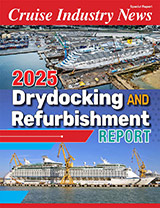![]() Fuel conservation, maintenance and recruitment are some of the issues that will keep marine and technical operations busy in 2007, in addition to new ship introductions and refurbishment projects.
Fuel conservation, maintenance and recruitment are some of the issues that will keep marine and technical operations busy in 2007, in addition to new ship introductions and refurbishment projects.
“We have made significant reductions in fuel consumption already,” said Captain William Wright, senior vice president of marine operations at Royal Caribbean International. “We are using more weather routing, paying more attention to currents. Before, we used to operate ships as if they were on railroad tracks. Now, we have a base route, but will deviate from that based on fuel optimization,” Wright explained.
Carnival Cruise Lines is also using weather routing. Brendan Corrigan, senior vice president of marine operations, said that the line has changed some itineraries as well as arrival and departure times in order to save fuel and is optimizing its use of engines, running three instead of four, for instance. “Collectively, it adds up,” he noted. “We have conservation meetings aboard the ships. The senior officers meet and talk about the different ways to save fuel. Conserving fresh water consumption, for instance, also helps to save fuel, because it takes fuel to generate water.
“Awareness is very important,” he added.
Corrigan said that it has been very helpful to provide more transparency. “Twenty years ago, ships’ crews were largely kept in the dark,” he said. “Now, it has made a big difference to involve them in the whole technical side, for environmental protection and safety.
At Costa Crociere, Franco Porcellacchia, senior vice president of technical operations, said that he too is considering weather tracking software, but waiting to see how it works for sister company Carnival first. Meanwhile, Costa has adjusted some itineraries, seeking to optimize fuel consumption between ports.
Holland America Line is testing weather tracking on the Noordam this winter, sailing from New York to the Caribbean. “The verdict is still out,” said Dan Grausz, senior vice president of fleet operations. He is also considering new propeller blades on some of the older ships citing tank tests that have shown a 5 percent fuel savings. The new propellers cost $750,000 each.
AIDA Cruises is also focused on fuel consumption, which Captain Burkhard Mueller, vice president of fleet services, said starts with itinerary planning, technical management and efficient operations.
“When we plan itineraries, we take weather and current into account,” added Nick Lighton, director of fleet management for P&O Cruises and Ocean Village. “We make sure we operate as efficiently as possible. We look at how the thermostats are set throughout the ship; we look at more efficient propellers; and we look at how well the ships move through the water.”
V. Ships Leisure CEO Lorenzo Malvarosa said that he will be focusing on the common denominators in the coming year – safety, onboard hygiene and compliance. V. Ships provide management, crewing and operating services to a variety of cruise ships – from budget to 6-star products.
Excerpt from the Cruise Industry News Quarterly Magazine: Winter 2006/2007



